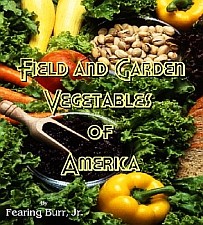
Field And Garden Vegetables of America

Description
Vegetables of America
Containing
Full Descriptions Of Nearly
Eleven Hundred Species
And Varieties; With Directions For
Propagation, Culture, And Use.
by
Fearing Burr, Jr.
The book is reprinted as an addition to the TGS Survival books. What better way to be prepared for disaster than with a garden and the knowledge of 'how to' garden. Further, with this book written in 1863, you learn 'how to' before the era of industrialization when modern tools were not yet invented.
Excerpt:
From the Introduction
Though embracing all the directions necessary for the successful management of a Vegetable Garden, the present volume is offered to the public as a manual or guide to assist in the selection of varieties, rather than as a treatise on cultivation.
With regard to the characteristics which distinguish the numerous varieties; their difference in size, form, color, quality, and season of perfection; their hardiness, productiveness, and comparative value for cultivation,-these details, a knowledge of which is important as well to the experienced cultivator as to the beginner, have heretofore been obtained only through sources scattered and fragmentary.
To supply this deficiency in horticultural literature, I have endeavored, in the following pages, to give full descriptions of the vegetables common to the gardens of this country. It is not, however, presumed that the list is complete, as many varieties, perhaps of much excellence, are comparatively local: never having been described, they are, of course, little known. Neither is the expectation indulged, that all the descriptions will be found perfect; though much allowance must be made in this respect for the influence of soil, locality, and climate, as well as for the difference in taste of different individuals.
 The Onion is a half-hardy biennial plant: the roots and leaves, however, are annual; as they usually perish during the first year. The bulbs, for which the plant is generally cultivated, are biennial, and differ to a considerable extent in their size, form, and color. The flower-stalk, which is developed the second year, is from three to four feet in height, leafless, hollow, swollen just below the middle, and tapers to the top. The flowers are either white or rose-colored, and are produced at the extremity of the stalk in a regular, globular group, or umbel. The seeds ripen in August. They are deep blue-black, somewhat triangular, and similar in size and form in all the varieties. An ounce contains about seventy-five hundred seeds, which retain their vitality two years.
The Onion is a half-hardy biennial plant: the roots and leaves, however, are annual; as they usually perish during the first year. The bulbs, for which the plant is generally cultivated, are biennial, and differ to a considerable extent in their size, form, and color. The flower-stalk, which is developed the second year, is from three to four feet in height, leafless, hollow, swollen just below the middle, and tapers to the top. The flowers are either white or rose-colored, and are produced at the extremity of the stalk in a regular, globular group, or umbel. The seeds ripen in August. They are deep blue-black, somewhat triangular, and similar in size and form in all the varieties. An ounce contains about seventy-five hundred seeds, which retain their vitality two years.
Soil and Cultivation.-The Onion requires a light, loamy, mellow soil; and, unlike most kinds of garden or field vegetables, succeeds well when cultivated on the same land for successive years. With the exception of the Top and the Potato Onion, all the varieties are raised from seed. Previous to sowing, the ground should be thoroughly spaded over or deeply ploughed, and the surface made smooth and even. The seed should be sown as early in spring as the soil may be in good working condition. Sow in drills fourteen inches apart, and half an inch in depth.
When the plants are three or four inches high, thin them to two inches asunder; and, in the process of culture, be careful not to stir the soil too deeply, or to collect it about the growing bulbs. The onions will ripen in August, or early in September; and their full maturity will be indicated by the perfect decay of the leaves, or tops. The bulbs may be drawn from the drills by the hand, or by the use of a common garden-rake. After being exposed for a few days to the sun for drying, they will be ready for storing or the market.
Preservation.-The essentials for the preservation of the bulbs are a low temperature, freedom from frost, dryness, and thorough ventilation.
Seed.-For the production of seed, select the ripest, firmest, and best-formed bulbs; and, in April, transplant them to lines two feet and a half or three feet distant, and from nine to twelve inches apart in the lines, sinking the crowns just below the surface of the ground. As the plants advance in height, tie them to stakes for support. The seeds ripen in August: and the heads, or umbels, should be cut off when they assume a brown color; for then the capsules begin to open, and shed their seeds. After being threshed out, the seed should be exposed to the action of the sun until it is thoroughly dried; for, when stored in a damp state, it is extremely liable to generate heat, and consequently to lose its vitality.
Varieties.-Few of the numerous varieties are cultivated to any extent in this country. Many of the kinds succeed only in warm latitudes, and others are comparatively unimportant. The Danvers, Large Red, Silver-skin, and the Yellow seem peculiarly adapted to our soil and climate. The annual product of these varieties greatly exceeds that of all the other sorts combined.
8¼" height 6¾" width - 565+ pages
Perfect-Bound














